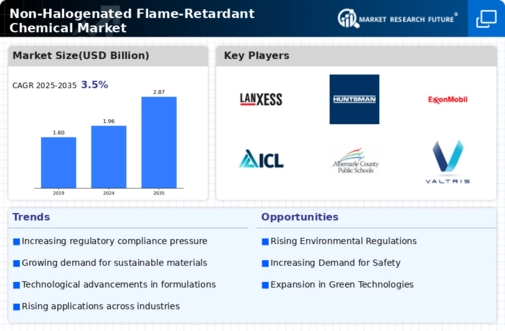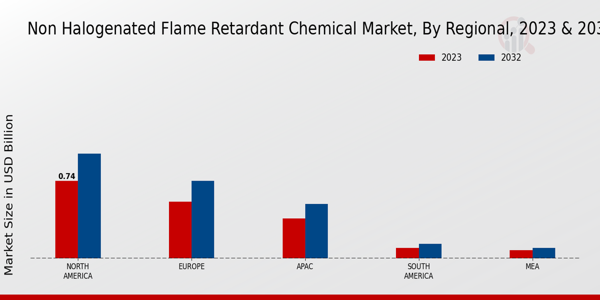Market Growth Projections
The Global Non-Halogenated Flame-Retardant Chemical Market Industry is projected to witness substantial growth in the coming years. With a market value anticipated to reach 1.96 USD Billion in 2024, the industry is expected to expand to 2.87 USD Billion by 2035. This growth trajectory indicates a compound annual growth rate of 3.52% from 2025 to 2035. Such projections reflect the increasing adoption of non-halogenated flame retardants across various sectors, driven by regulatory pressures, technological advancements, and a growing emphasis on environmental sustainability.
Increasing Regulatory Pressure
The Global Non-Halogenated Flame-Retardant Chemical Market Industry is experiencing heightened regulatory scrutiny as governments worldwide enforce stricter safety standards. Regulations aimed at reducing the environmental impact of halogenated flame retardants are driving manufacturers to seek non-halogenated alternatives. For instance, the European Union's REACH regulation mandates the assessment of chemical substances, which encourages the adoption of safer flame retardants. This shift is expected to contribute to the market's growth, with projections indicating a market value of 1.96 USD Billion in 2024, potentially reaching 2.87 USD Billion by 2035, reflecting a compound annual growth rate of 3.52% from 2025 to 2035.
Diverse Applications Across Industries
The versatility of non-halogenated flame retardants across various industries is a key driver for the Global Non-Halogenated Flame-Retardant Chemical Market Industry. These chemicals find applications in construction, automotive, textiles, and consumer goods, among others. The increasing need for fire safety in these sectors is propelling the demand for non-halogenated alternatives. For instance, the construction industry is adopting these flame retardants in insulation materials and coatings to enhance fire resistance. This broad applicability is expected to support market growth, with estimates suggesting a rise from 1.96 USD Billion in 2024 to 2.87 USD Billion by 2035.
Growing Demand from Electronics Sector
The electronics sector is a significant driver for the Global Non-Halogenated Flame-Retardant Chemical Market Industry, as manufacturers increasingly prioritize safety and compliance with international standards. Non-halogenated flame retardants are preferred in electronic applications due to their lower toxicity and environmental impact. For example, the use of these chemicals in circuit boards and casings enhances fire safety without compromising performance. As the electronics industry continues to expand, the demand for non-halogenated flame retardants is likely to increase, contributing to the market's projected growth from 1.96 USD Billion in 2024 to 2.87 USD Billion by 2035.
Technological Advancements in Flame Retardants
Technological advancements are playing a crucial role in shaping the Global Non-Halogenated Flame-Retardant Chemical Market Industry. Innovations in chemical formulations and processing techniques have led to the development of more effective non-halogenated flame retardants that meet stringent safety standards. These advancements not only enhance the performance of flame retardants but also reduce their environmental impact. As manufacturers adopt these new technologies, the market is poised for growth, with projections indicating an increase from 1.96 USD Billion in 2024 to 2.87 USD Billion by 2035, reflecting a compound annual growth rate of 3.52% from 2025 to 2035.
Rising Awareness of Environmental Sustainability
There is a growing awareness regarding environmental sustainability, which is significantly influencing the Global Non-Halogenated Flame-Retardant Chemical Market Industry. Consumers and manufacturers alike are increasingly concerned about the ecological footprint of their products, prompting a shift towards more sustainable materials. Non-halogenated flame retardants are viewed as a more environmentally friendly option, aligning with global sustainability goals. This trend is expected to bolster market growth, with estimates suggesting a rise from 1.96 USD Billion in 2024 to 2.87 USD Billion by 2035, driven by a compound annual growth rate of 3.52% from 2025 to 2035.











